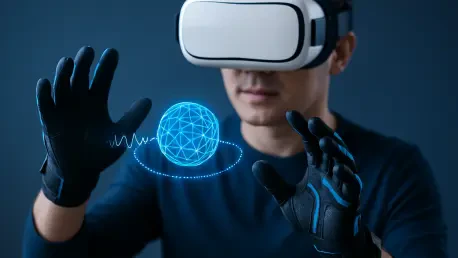Imagine a world where a surgeon in New York can perform a delicate operation on a patient in Tokyo with the same precision as if they were in the same room, feeling every movement in real time, thanks to the imminent reality of haptic internet technology. This innovation enables ultra-low latency communication and tactile feedback for remote and immersive interactions. Valued at USD 1.2 billion today, this market is on track to explode to USD 28.4 billion by 2035, reflecting a compound annual growth rate (CAGR) of 37.2%. Such staggering growth, over 23 times the current value in just a decade, signals a transformative shift across industries like healthcare, gaming, and industrial automation. The technology’s ability to deliver split-second sensory responses is not just innovative—it’s revolutionary, promising to redefine how digital and physical worlds converge.
This remarkable trajectory isn’t merely a statistical projection but a reflection of converging technological advancements and escalating demand for real-time interaction. Between now and 2030, the market is expected to climb to USD 6.8 billion, laying critical groundwork through early adoption and infrastructure development. The true surge, however, will unfold from 2030 to 2035, with an additional USD 21.6 billion in value, accounting for nearly 80% of the total growth. This acceleration points to maturing systems and broader accessibility, positioning haptic internet as a cornerstone of modern communication. As the implications ripple across sectors and regions, understanding the drivers, challenges, and opportunities becomes essential to grasping the full scope of this technological wave.
Market Growth and Projections
Early Growth Phase (2025-2030)
The haptic internet market is poised for a significant leap in its initial phase, growing from USD 1.2 billion to USD 6.8 billion by 2030. This period will serve as a proving ground, where early adopters in key industries like healthcare and gaming validate the technology’s potential. The addition of USD 5.6 billion in value during these five years highlights the rapid uptake driven by foundational investments in ultra-low latency networks. Critical applications, such as remote surgical procedures requiring flawless real-time feedback, will push companies to refine hardware and software solutions. This phase is less about widespread adoption and more about establishing reliability and trust in the technology, setting the stage for broader market penetration.
Beyond the numbers, this early growth reflects a strategic focus on building robust infrastructure to support haptic applications. Governments and private entities are prioritizing pilot projects, particularly in tech-savvy regions, to test the limits of tactile communication. The emphasis during this window will be on overcoming initial technical hurdles, such as ensuring consistent sub-millisecond response times across diverse environments. Success here will hinge on collaboration between network providers and hardware developers to create seamless systems. As these efforts bear fruit, confidence in haptic internet’s capabilities will grow, encouraging more industries to explore its potential and paving the way for the explosive expansion in the following years.
Explosive Expansion (2030-2035)
From 2030 to 2035, the haptic internet market is forecasted to skyrocket from USD 6.8 billion to USD 28.4 billion, adding a staggering USD 21.6 billion in value. This phase marks a turning point where the technology transitions from niche applications to mainstream integration across multiple sectors. The maturity of supporting infrastructure, such as widespread 5G coverage and emerging 6G networks, will enable scalability, making haptic solutions more accessible to smaller enterprises and developing regions. This period will likely see haptic feedback embedded in everyday consumer devices, from gaming consoles to educational tools, driving exponential demand and transforming user expectations of digital interaction.
This dramatic surge also underscores the broadening scope of applications as industries recognize the value of real-time tactile feedback. Industrial automation will expand significantly, with remote-controlled machinery becoming standard in manufacturing hubs. Simultaneously, entertainment sectors will push boundaries with hyper-immersive virtual reality experiences that captivate global audiences. The economic impact will be profound, as cost barriers lower through technological advancements and economies of scale. By 2035, the market’s growth will not just reflect financial gains but a fundamental shift in how societies operate, with haptic internet enabling seamless remote collaboration and interaction on an unprecedented level.
Technological Drivers
Network Advancements (5G and 6G)
The backbone of the haptic internet’s rise lies in the transformative power of 5G networks, which have already slashed latency to levels previously unimaginable, often below a millisecond. This speed is critical for applications where even the slightest delay can disrupt outcomes, such as in telemedicine or precision manufacturing. As 5G infrastructure continues to expand globally, it provides the essential framework for real-time tactile feedback, allowing users to experience digital interactions as if they were physical. The widespread deployment of this technology across urban and rural areas alike is fueling early market growth, enabling industries to adopt haptic solutions with confidence in their reliability and performance.
Looking further ahead, the emergence of 6G technology promises to push these boundaries even further, targeting sub-millisecond response times that could redefine the limits of haptic applications. Although still in developmental stages, 6G is anticipated to integrate advanced features like massive connectivity and enhanced data rates, supporting complex haptic systems across vast networks. This next-generation leap will likely accelerate the market’s expansion in the 2030-2035 period, as it enables more intricate and widespread use cases. From supporting entire smart cities with tactile interfaces to enhancing global remote operations, 6G stands as a catalyst that could elevate the haptic internet from a specialized tool to a ubiquitous standard.
Edge Computing and AI Integration
Edge computing plays a pivotal role in the haptic internet ecosystem by processing data closer to the end user, significantly reducing latency that could otherwise hinder real-time feedback. By decentralizing data handling and minimizing reliance on distant servers, this technology ensures that tactile responses occur almost instantaneously, a necessity for high-stakes scenarios like remote surgery or industrial control. Its adoption is particularly impactful in regions with robust digital infrastructure, where localized processing can seamlessly integrate with existing networks. As edge computing solutions become more cost-effective, their implementation will likely broaden, supporting the market’s growth by making haptic technology viable in diverse settings.
Complementing this, artificial intelligence (AI) and machine learning (ML) are enhancing haptic experiences through sophisticated optimization techniques. These technologies enable predictive rendering, where systems anticipate user actions to deliver smoother feedback, and adaptive responses that tailor interactions to individual preferences. Such advancements are proving invaluable in consumer-facing sectors like gaming, where personalized tactile sensations heighten immersion. Moreover, AI-driven analytics help refine system efficiency, reducing resource demands and addressing cost concerns. Together, edge computing and AI form a dynamic duo that not only powers current haptic solutions but also drives innovation, ensuring the technology evolves to meet increasingly complex demands.
Sectoral Impacts
Healthcare and Telemedicine
Healthcare stands at the forefront of haptic internet adoption, commanding a 35.0% market share as of now, largely due to its critical need for precision in applications like remote surgery. The ability to perform complex procedures from thousands of miles away, with tactile feedback mimicking direct touch, is revolutionizing telemedicine. Surgeons can feel the resistance of tissue or the pressure of instruments in real time, ensuring accuracy that rivals in-person operations. This capability not only expands access to specialized care in remote or underserved areas but also enhances training programs, where practitioners can simulate surgeries with lifelike sensory input, making this sector a primary driver of market investment.
Beyond surgical applications, haptic technology is transforming rehabilitation and medical education within healthcare. Patients recovering from injuries can use tactile systems to engage in guided physical therapy remotely, feeling therapist-directed movements through connected devices. Meanwhile, medical students benefit from virtual environments that replicate the tactile nuances of human anatomy, offering hands-on learning without physical specimens. These diverse applications underscore healthcare’s reliance on ultra-low latency and reliability, pushing technology providers to prioritize robust solutions. As a result, this sector will likely maintain its lead, shaping standards for haptic performance that influence other industries over the coming decade.
Industrial Automation and Gaming
Industrial automation represents another powerhouse for haptic internet, particularly in regions like Japan, where it holds a significant share of the market due to advanced robotics integration. The technology enables workers to control machinery remotely with pinpoint accuracy, feeling every adjustment as if they were on-site. This enhances operational efficiency and safety, reducing the need for physical presence in hazardous environments like factories or mining operations. The demand for such precision-driven applications is accelerating infrastructure development, as companies seek to leverage tactile feedback to streamline processes and minimize downtime, positioning automation as a key growth area.
In contrast, the gaming and entertainment sector, especially prominent in South Korea with a 38.4% share, focuses on delivering immersive experiences through virtual reality (VR) and augmented reality (AR). Haptic feedback allows players to feel the impact of in-game actions, from the recoil of a weapon to the texture of a virtual surface, blurring the line between digital and real. This sensory depth captivates users, driving consumer demand for advanced gaming hardware and software. As VR and AR technologies become more mainstream, entertainment applications will continue to push haptic innovation, exploring new ways to engage audiences and expand market reach through emotionally resonant digital interactions.
Regional Dynamics
Asia Pacific Leadership
Asia Pacific emerges as the undisputed leader in the haptic internet market, with countries like China, Japan, and South Korea posting remarkable CAGRs of 44.8%, 42.7%, and 41.3% respectively through 2035. China’s dominance stems from massive government investments in 5G and 6G infrastructure, creating an ideal environment for haptic technology to flourish across industrial and consumer applications. This strategic focus on next-generation networks, combined with a vast manufacturing base, positions the country to drive global standards and adoption rates. The scale of deployment here serves as a blueprint for rapid technological rollout, influencing other regions to follow suit with similar ambitious initiatives.
Japan, meanwhile, leverages its expertise in robotics and healthcare to carve a niche in precision-driven haptic applications. The emphasis on industrial automation, where remote control of complex machinery demands flawless tactile feedback, fuels market growth. Simultaneously, South Korea blends telecommunications prowess with a cultural affinity for gaming, making it a hub for consumer-oriented haptic tech in VR and AR. These countries collectively highlight Asia Pacific’s multifaceted approach, where infrastructure, innovation, and local demand converge to create unparalleled growth momentum. This regional strength not only accelerates the global market but also fosters cross-border collaboration and knowledge sharing.
North America and Europe
North America, led by the USA with a 37.2% CAGR through 2035, benefits from a robust technology ecosystem that balances broad innovation with enterprise adoption. The region’s strength lies in its research and development capabilities, with major tech hubs driving advancements in haptic hardware and software. While growth is slightly tempered by market maturity compared to Asia Pacific, the focus on integrating haptic solutions into diverse sectors like healthcare and automotive ensures steady progress. This balanced approach positions North America as a critical player, contributing significantly to global standards and pushing for scalable solutions that address both consumer and industrial needs.
Europe, with Germany at the forefront posting a 39.6% CAGR, showcases a strong industrial focus aligned with Industry 4.0 goals. The emphasis on automation in manufacturing drives demand for haptic feedback in remote machinery control, enhancing precision and efficiency. Germany’s leadership is complemented by broader European efforts to integrate haptic technology into smart infrastructure and telemedicine, supported by collaborative policies across the region. Though growth rates are somewhat lower than in Asia Pacific due to established tech bases, Europe’s strategic investments in innovation ensure it remains a vital contributor to the market’s evolution, particularly in setting regulatory and quality benchmarks for global adoption.
Challenges and Opportunities
Barriers to Adoption
The haptic internet market faces significant hurdles that could temper its rapid ascent, chief among them being the high cost of infrastructure development. Building ultra-low latency networks and deploying advanced hardware like tactile sensors and actuators requires substantial investment, often out of reach for smaller companies or less developed regions. This financial barrier risks creating a digital divide, where only well-funded entities can fully leverage the technology. Addressing this disparity will be crucial to ensure equitable growth, as limited access could slow overall market expansion and hinder the technology’s transformative potential in critical areas like healthcare.
Additionally, technical complexities and standardization issues pose formidable challenges to widespread adoption. The intricate nature of maintaining sub-millisecond latency across global networks demands sophisticated integration of hardware, software, and connectivity solutions, often leading to compatibility issues. Without unified protocols, the risk of fragmentation looms large, potentially stalling interoperability between systems and applications. Privacy and security concerns, especially in cloud-based deployments handling sensitive data, further complicate the landscape. These barriers necessitate industry-wide cooperation to develop cost-effective, secure, and standardized frameworks that can sustain the market’s momentum through 2035.
Emerging Prospects
Despite the challenges, the haptic internet market brims with opportunities that could propel it to new heights, particularly through expansion into untapped sectors. Fields like education and retail hold immense potential, where tactile feedback could revolutionize virtual learning environments or enhance online shopping with sensory product interactions. Exploring these areas not only diversifies application scope but also drives demand for innovative solutions tailored to unique user needs. As companies identify and develop these emerging use cases, the market stands to gain fresh momentum, broadening its impact beyond traditional strongholds like healthcare and gaming.
Another promising avenue lies in leveraging AI for personalization and efficiency, which could significantly elevate user experiences. By tailoring haptic feedback to individual preferences, especially in consumer applications like VR gaming or training simulations, companies can create a competitive edge that captivates audiences. Simultaneously, government support through policies funding 5G/6G rollouts or smart city initiatives offers a powerful boost, creating fertile ground for haptic technology deployment. These combined prospects—new sectors, AI advancements, and policy backing—provide a roadmap to overcome existing barriers, ensuring the market’s growth remains robust and inclusive as it approaches a projected value of USD 28.4 billion by 2035.









